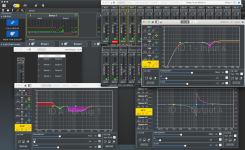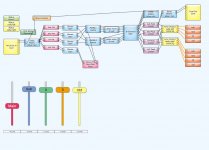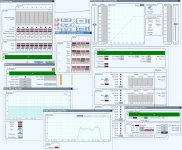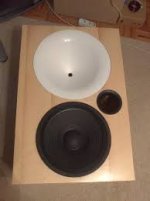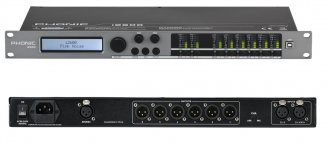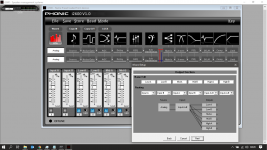There can be excellent high sensitivity low Mms drivers, no doubt about that. Here in Europe we have somewhat sparse experience with AE drivers - quite exotic stuff. We use mainly the Italian PA drivers because of their availability...
Do you have any measurements to share?
Do you have any measurements to share?
Last edited:
- and I have nothing against the fun! That's perfectly fine.
Absolutely, I have re-utilized my Bib speakers and mated them with a FRSx5+ horn. I'm surprised about the quality without any measurements made. Although I have ordered XTZ room analyzer pro 2, coming in October
Where to go from here?
To the pub after measurements failed? ;o) Joke aside, for a normal person, probably not possible but perhaps close enough
There can be excellent high sensitivity low Mms drivers, no doubt about that. Here in Europe we have somewhat sparse experience with AE drivers - quite exotic stuff. We use mainly the Italian PA drivers because of their availability...
Do you have any measurements to share?
The AE stuff is indeed exotic on this side of the pond. Fortunately, about 80% of the quality PA stuff is being produced in Europe these days.
Guys, just a question as this puzzles me - when you try and compare all those horns and drivers, do you allways measure it acoustically for all the polars to make a proper crossover? Or how do you do it? It must take a heck of a time.
My experience from my method, is that making the proper xover is a lot easier and less time consuming than juggling basic on and off axis response variations.
The usable range of crossover frequencies where pattern control blends smoothly seems fairly well dictated by cone size and horn pattern.
A quick spin on the turntable, as reflection free as possible, is enough to get a good idea of the usable range. Dual channel FFT, with real-time 'watch transfer response change as you spin', makes this go quickly.
I don't think you can really change polar response variations much with crossover design. That comes from smoothing out each individual drivers' transfers before summation.
About all the crossover contributes from a polar viewpoint, is how well polars blend in the crossover region. Which as first stated, seems to be mandated by physical size / waveguide angles..
So if individual drivers are properly corrected first, it just becomes matter of being able to slide x-over up and down the usable range easily, to find optimum polar smoothness at crossover.
I use complementary linear phase crossovers, and it's nearly trivial to slide xover up and down because there aren't any changing group delay times to adjust. And by using steep xovers, vertical polar variations are kept to a minimum. And again, by having drivers individually corrected first, summation stays smooth as xover is moved around. Easy peasy
However, juggling on and off axis response variations, which span a much wider frequency range than the crossover region, is huge work ime.
The variations aren't minimum phase, so they can't be corrected, and it's a painstaking process of choosing your poison, ime
The big round horns are unbeatable if you value "preservation of the signal".
My personal experience is mostly limited to Avantgarde and Oris horn speakers, which are not the best examples.
People often expect a "huge soundstage" judged by the looks of these big horns.
As we all know, this isn't the case.
Mark(100), which tools - DSP, I suppose, do you use?
My personal experience is mostly limited to Avantgarde and Oris horn speakers, which are not the best examples.
People often expect a "huge soundstage" judged by the looks of these big horns.
As we all know, this isn't the case.
Mark(100), which tools - DSP, I suppose, do you use?
Docali, If the horn does not suit me, I guess I can just try another horn, I didn’t think it was that complicated, rather, a journey. I really like the off axis performance of round horns so, I’d say that this may be highly personal and that it may be a stretch for you to decide what is or is not a reference design based on that one insignificant aspect. I consider how linear the rest of the off axis response of a long round horn to be a huge advantage in referencing. The potential of a extremely flat voicing as result of not having to eq other horn induced anomalies is appeasing as well. Still I’ve accepted that this may or may not be the horn for me, and the driver behind it suits me and my endeavor. I theorized that best performance of any HF driver was within the first 15 degrees so even though it’s not as obvious, even a 1” done requires the same discipline in the approach of critical listen technique.
If the way is your goal then have a good journey! This is what makes our hobby fascinating...
For making the EQs, crossovers, which are imbedded into FIR files...rePhase and FirDesigner.
For making measurements....REW and Smaartlive
Thanks!
Anybody using this?
Overkill at home, but nonetheless an advanced all-in-one solution.
Attachments
Yep Ro808, there are awesome new processing platforms coming out every day.
Outline's Newton you showed looks interesting.
The thing about it, and other similar hardware devices that bugs me though, is hardware cost$$$$...
and knowing how quickly the hardware will head in to obsolescence.
That's what has driven me to Q-Sys.. The hardware cost is there, but much much less than examples like Newton...and cost is occasionally even kinda low when you grab gear off ebay that came out of an install.
Because the cool thing with Q-Sys is that it is software based, designed to be compiled on q-sys cores. So there are no operating system issues to contend with. And the software has the same capabilities no matter how large or small the audio design. Mega hardware processing is only needed for mega sized installations.
Below is a q-sys design screen grab for one of my multiways.
Each component in the design blows up for use/adjustment/monitoring, like shown for a few components in the second pict.
I love it !
Outline's Newton you showed looks interesting.
The thing about it, and other similar hardware devices that bugs me though, is hardware cost$$$$...
and knowing how quickly the hardware will head in to obsolescence.
That's what has driven me to Q-Sys.. The hardware cost is there, but much much less than examples like Newton...and cost is occasionally even kinda low when you grab gear off ebay that came out of an install.
Because the cool thing with Q-Sys is that it is software based, designed to be compiled on q-sys cores. So there are no operating system issues to contend with. And the software has the same capabilities no matter how large or small the audio design. Mega hardware processing is only needed for mega sized installations.
Below is a q-sys design screen grab for one of my multiways.
Each component in the design blows up for use/adjustment/monitoring, like shown for a few components in the second pict.
I love it !
Attachments
Good tip about the QSC Q-Sys, Mark100!
It's a fact these (proprietary) platforms become obsolete rather quickly.
Unfortunately, the digital inputs and DACs are often lacking in quality and resolution, especially with the cheaper units.
This is an exception; limited to 48kHz AES/EBU and no FIR support, but decent low noise DAC/DSP stage (AKM).
It's on par with the Xilica units wrt audio quality and also very cheap nowadays > around €250 new.
It's a fact these (proprietary) platforms become obsolete rather quickly.
Unfortunately, the digital inputs and DACs are often lacking in quality and resolution, especially with the cheaper units.
This is an exception; limited to 48kHz AES/EBU and no FIR support, but decent low noise DAC/DSP stage (AKM).
It's on par with the Xilica units wrt audio quality and also very cheap nowadays > around €250 new.
Attachments
Last edited:
Zvu's 2-way with B&C DE250 + OSWG + Beyma 15K200:
(Could only find this thumb)
I'll find you a bigger one as soon as i get back from Possidi-Greece since i'm in a holliday with wife and kids for some time now. It's a small place about an hour from Thessaloniki with wide and long sand beaches. So in a few days i guess
Last edited:
@Mark100, which hardware do you use?
The Q-Sys platform/ecosystem appears to be one of the most comprehensive, versatile and future-proof on the market.
The Newton, in the basic version without analogue inputs / outputs is listed at € 6,500.
Four analogue inputs and outputs are available at a surcharge of € 1,500 and eight each for € 3,000.
System-On-Modules are PicoZed, based on the Xilinx Zynq-7000 SoC.
Newton is MacOS only.
The Q-Sys platform/ecosystem appears to be one of the most comprehensive, versatile and future-proof on the market.
The Newton, in the basic version without analogue inputs / outputs is listed at € 6,500.
Four analogue inputs and outputs are available at a surcharge of € 1,500 and eight each for € 3,000.
System-On-Modules are PicoZed, based on the Xilinx Zynq-7000 SoC.
Newton is MacOS only.
Attachments
-
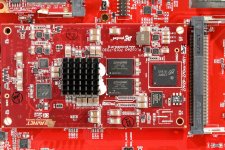 Outline-Newton-DSC_4281.jpg407.4 KB · Views: 75
Outline-Newton-DSC_4281.jpg407.4 KB · Views: 75 -
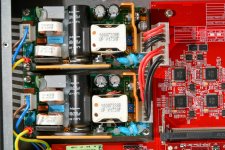 Outline-Newton-DSC_4268.jpg335 KB · Views: 69
Outline-Newton-DSC_4268.jpg335 KB · Views: 69 -
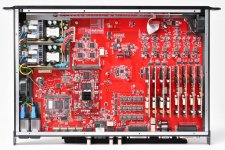 Outline-Newton-DSC_4277.jpg339.1 KB · Views: 72
Outline-Newton-DSC_4277.jpg339.1 KB · Views: 72 -
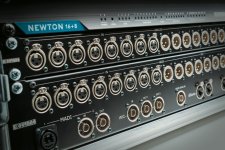 Outline-Newton-IMG_1738.jpg232.8 KB · Views: 78
Outline-Newton-IMG_1738.jpg232.8 KB · Views: 78 -
 Outline-Newton-DSC_4238.jpg66.1 KB · Views: 63
Outline-Newton-DSC_4238.jpg66.1 KB · Views: 63 -
 Outline-Newton-DSC_4237.jpg39.1 KB · Views: 72
Outline-Newton-DSC_4237.jpg39.1 KB · Views: 72 -
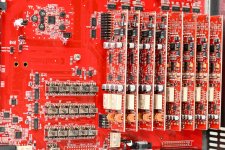 Outline-Newton-DSC_4279.jpg457.2 KB · Views: 55
Outline-Newton-DSC_4279.jpg457.2 KB · Views: 55
Last edited:
 - So I came across some reading suggesting that the anomalies seen starting around 10khz are the result of a mismatching of exit angle to horn. Very glad that the jbl 2451 is throatless.
- So I came across some reading suggesting that the anomalies seen starting around 10khz are the result of a mismatching of exit angle to horn. Very glad that the jbl 2451 is throatless.Those DSP systems look nice but for me the most important aspect, after signal quality, is the amount of control points on the eq....I think the DSP on my crowns have something like 16 per channel
The QSC layout looks very similar to the crown software, except I don't have the most up to date hardware that includes FIR filtering...which is fine since I rather do that ITB anyway.
Last edited:
Marcel was on comparing drivers. Some put each on the same horn and say one sounds different. Some EQ first. Does anyone do a full crossover for each first?
The question was, is there any real difference? Few outspoken people tend to agree.
The question was, is there any real difference? Few outspoken people tend to agree.
Perhaps, but you're missing the subtleties this way. How the match isn't perfect, what the offset does, how the power influences the response.I don't think you can really change polar response variations much with crossover design.
@Mark100, which hardware do you use?
The Q-Sys platform/ecosystem appears to be one of the most comprehensive, versatile and future-proof on the market.
The Newton, in the basic version without analogue inputs / outputs is listed at € 6,500.
Four analogue inputs and outputs are available at a surcharge of € 1,500 and eight each for € 3,000.
System-On-Modules are PicoZed, based on the Xilinx Zynq-7000 SoC.
Newton is MacOS only.
I use a Q-Sys Core 110f.
I think new, from the right authorized seller, they go for about $2250.
I've seen them trade used on ebay for $750 to $1700. They are very robust, I would not worry about used from a legit seller.
Newton prices are just plain crazy IMO.
But then again, msrp q-sys prices look crazy too
Perhaps, but you're missing the this way. How the match isn't perfect, what the offset does, how the power influences the response.
Sure, maybe i am missing those subtleties..
But honestly, that's a big part of my process...to eliminate any such subtleties.
I've found if I correct driver by driver, and then sum them with linear phase phase crossovers, what i used to call subtleties simply turn into anomalies.
- Home
- Loudspeakers
- Multi-Way
- Is it possible to cover the whole spectrum, high SPL, low distortion with a 2-way?
